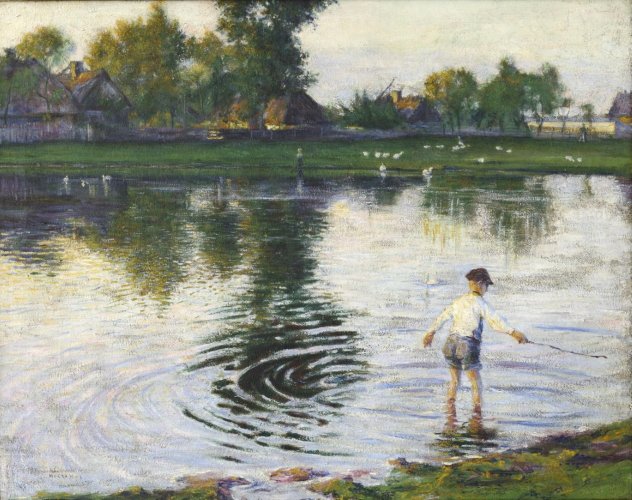Description:
Władysław Podkowiński (1886-1895) studied at the Warsaw Drawing Class under Wojciech Gerson from 1880 to 1885. For a year he attended the Imperial Academy in St. Petersburg as a free listener. In 1889, together with Józef Pankiewicz, he went to Paris. There, the retrospective exhibition of Claude Monet had a huge influence on his creativity, inspiring him to accept Impressionism. The Warsaw exhibition in 1890, where he and Pankiewicz presented their Paris works, despite criticism, decided the introduction of Impressionism into Polish art. In the two following years, during plein airs in Mokra Wieś and Chrzesnem, the artist created the banner works for this direction. He also painted symbolic paintings, of which the most famous “Frenzy” was recognized by the younger generation of artists as a manifesto of new art*.
The trips to the estates of Mokra Wieś and Chrzesnem were fruitful with many works of the artist. The second of them brought a series of plein air paintings, one of them being “Mokra Wieś”. The landscape is one of the artist’s most popular works. In an impressionistic view, it shows the serene landscape of a Polish village. The chosen time of day – sunset – allows for the presentation of a rich range of light phenomena, it also emphasizes the romantic dimension of the landscape.
‘Description of the painting:
Mokra Wieś’ was painted during the artist’s second plein air in the titular village. It depicts a view of a pond at sunset, taking up almost the entire painting surface. The water’s surface is painted with a bright, silver palette of colors. The reflection of the distant other side of the pond can be seen in it. A boy wading in the water is placed in the foreground. His movements are emphasized by the circles spreading around him, which also mark the traces of blows with a stick held in his hand. The boy is dressed modestly – in a white shirt and rolled-up pants. The second plan, showing the opposite side of the pond, is built of horizontal strips. The closest to the water is covered with lush green meadow, on which white geese graze. At the water, in the center, the outline of another figure can be seen – a woman in a skirt, who disappears in the shade of a mighty tree setting the vertical axis of the composition. On its sides, the rural houses spread, shaded by lower trees with lush crowns. The buildings are wooden, covered with thatch, they are bathed in golden rays of the setting sun. At the right edge of the painting, there is a gap between the farms opening a view of the vast field covered with grain fields. Above the view stretches a milky-blue sky with shades of violet and pink, whose reflection gives a similar color to the water.
The depiction of a fleeting moment, the brightening of the palette, the capture of color relationships shaped by light and chromatic proximity, as well as the divisionist technique indicate the influence of Impressionism on Podkowiński. However, he added a specific mood to the fleeting frame and the impression of light phenomena, thus creating a romantic view of a peaceful Polish village. The framing of the boy playing at the end of the day shows the moment of respite after the hardships of daily work in the field.


